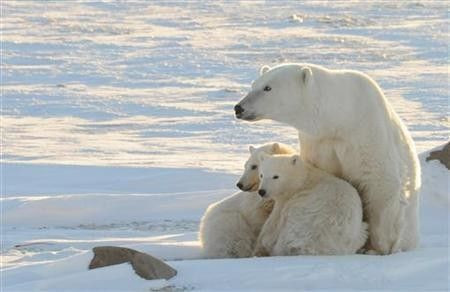Polar Bear Gene Study Finds Earlier Origin, Tracks Traces Of Climate Change

A new genetic study of polar bears shows that they probably interbred with brown bears during ancient times of climate change - and that the current warming trend could lead to more of the same.
A group of researchers led by Pennsylvania State University and University of Buffalo scientists performed deep genome sequencing on a polar bear, three brown bears and a black bear. They also looked at samples from an additional 23 polar bears, including one that lived 120,000 years ago, to get a sense of the polar bear's evolutionary history.
It turns out that polar bears have been around longer than previously estimated. Other studies have pegged polar bear origin at around 600,000 years ago, but they've actually existed as a distinct species as early as 5 million years ago, according to the group's new paper in the Proceedings of the National Academy of Sciences.
This earlier origin date means polar bears definitely persisted through warming periods during Earth's history, University of Buffalo biologist and senior author Charlotte Lindqvist said in a statement Monday.
They also found that two of the brown bears that hailed from an isolated population in Alaska's Alexander Archipelago were more closely related to the polar bear than to the other brown bear, sharing between 5 and 10 percent of the polar bear's genes. The scientists estimated that polar bears and the Alexander Archipelago brown bear population split somewhere around 150,000 years ago.
Despite being separate species, this relatively recent split raises the possibility that brown and polar bears could breed as polar bears - a phenomenon that has been documented both in zoos and, in very rare cases, in the wild. In 2006, wildlife officials confirmed that a white bear with brown patches of fur and an oddly humped back was a polar bear-grizzly hybrid. (Grizzlies are a subspecies of brown bear, not a unique species.)
The researchers think that the genetic traces of recent intermingling means that polar bears were driven into brown bear ranges by previous warming events.
But just because the polar bear species has weathered previous periods of climate change, that doesn't guarantee they're gonna survive the next warm period, lead author and Penn State researcher Webb Miller said in a phone interview.
For one, the pace of climate change at present is more rapid than any other period the polar bears have dealt with before, according to Webb.
Polar bears may be forced to spend increasingly more time on land, perhaps even during the breeding season, and therefore come into contact with brown bears more frequently, the authors wrote.
More interbreeding with brown bears does threaten the continued existence of a unique polar bear species, but it isn't the only threat. The scientists found that, somewhat unsurprisingly, as polar bears have dwindled in number in modern times, they've become less diverse genetically.
Because of this, they are very likely more sensitive to climate change threats today, Lindqvist said.
SOURCE: Miller et al. Polar and brown bear genomes reveal ancient admixture and demographic footprints of past climate change. PNAS online before print 23 July 2012.
© Copyright IBTimes 2024. All rights reserved.





















